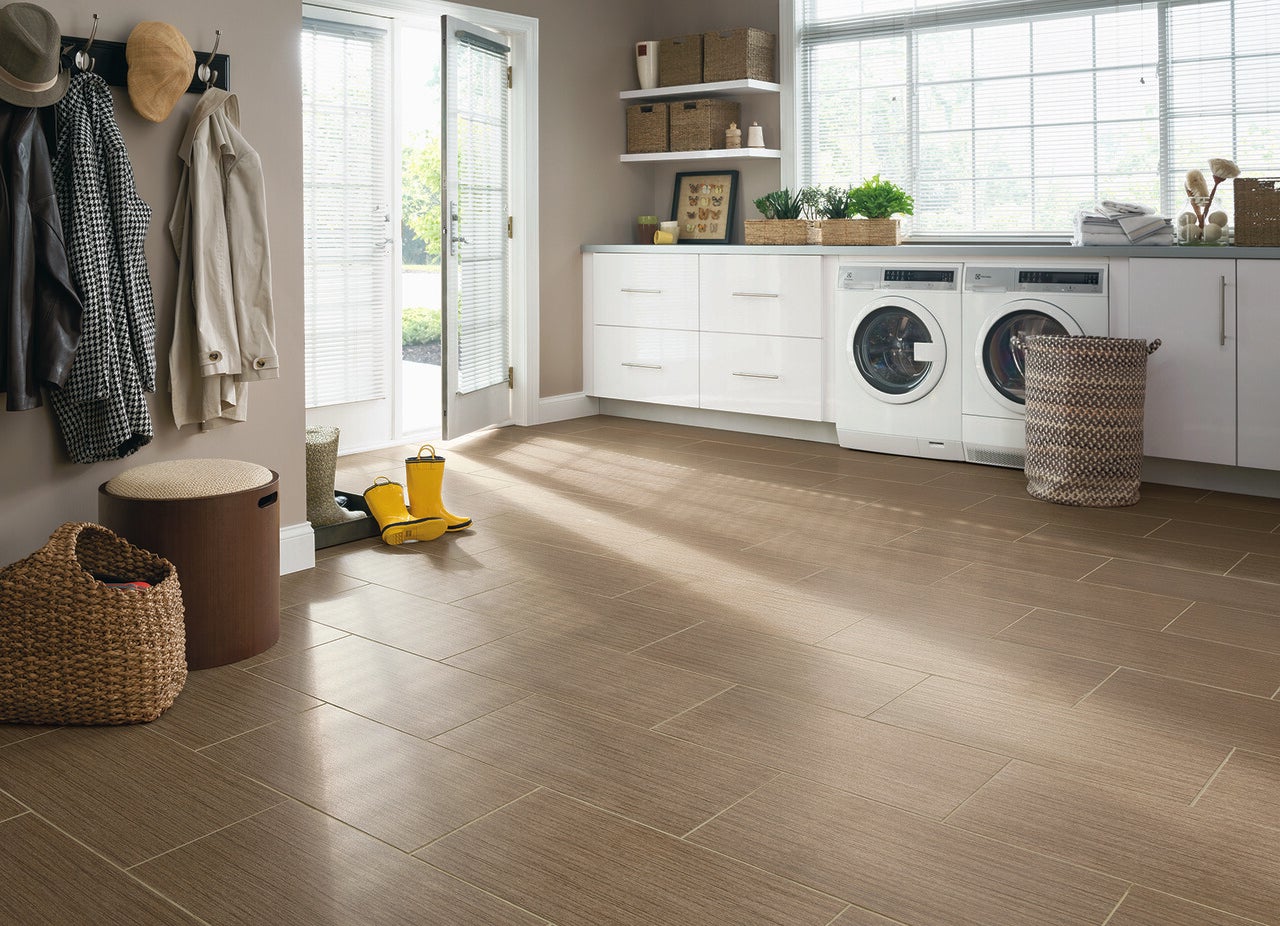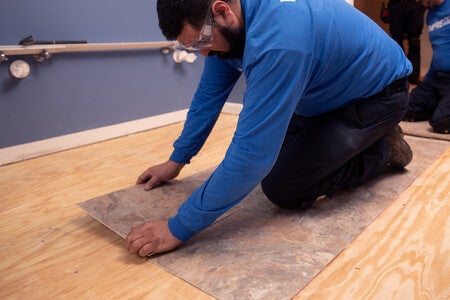
You wake up on a bitterly cold winter morning and shuffle into your kitchen for coffee. The moment your foot hits the tile – crack. Your stomach drops.
What just happened?
Unfortunately, you’ve just found your first tile crack. Cracked tiles in winter are an exceedingly common headache for homeowners due to temperature changes, excess moisture, and shoddy installation.
Fortunately, there’s good news: if you update your knowledge and take the right precautions, you can make sure your tile floors survive the winter harshness. Whether it’s existing cracks or avoiding more costly repairs, we’ll walk you through how winter affects tile flooring – and what you can do about it.
Why Does Cold Weather Destroy Tile?
When you installed your tile, you might have felt like it was indestructible. But, like all materials, it reacts in certain ways to its environment.
Tile’s main problem is that it’s not very flexible. It’s supposed to be rigid and unyielding. And when winter rolls in, it creates a major issue.
Thermal Expansion & Contraction
When temps drop, tiles contract slightly. And when it warms up – typically from indoor heating – they expand again. This repeated stress over time can weaken your tiles and cause cracked tiles in winter.
Freeze & Thaw Cycles
Water can sneak into microscopic pores in your tile and grout. Once temperatures fall below freezing, that water expands and forces the material apart. This results in tiles lifting, popping, and cracking.
Subfloor Instability
Does your home experience major temperature swings? If so, your subfloor (the layer beneath your tile) will expand and contract with the temperature and slightly shift. This tiny movement puts pressure on the tiles above and causes them to loosen or break.
Which Tiles Suffer the Most Winter Flooring Problems?
Depending on the type of tile you install in your home – or the way it’s installed – you may have more problems with cracked tiles in winter.
- Porcelain Tile: Porcelain is your best option if you live in an area plagued by brutal winters. It’s dense and absorbs very little moisture compared to other options. Thus, it’ll resist cracking better than other types.
- Ceramic Tile: Ceramic is more porous than porcelain, which means it’ll absorb more moisture. It’s more prone to cracking when those temperatures plummet.
- Natural Stone: Stone looks incredible but can be a nightmare in harsh winters. Stone flooring like marble or limestone absorbs a ton of moisture, which makes it highly susceptible to freeze-thaw damage.
- Poorly Installed Tile: Even the highest quality tile won’t survive a tough winter if it was poorly installed. If the wrong adhesive was used or expansion joints weren’t included, you can expect cracked tiles in winter.
Curious about the many tile options out there? Want to learn more about how you can upgrade your home’s flooring and what it might cost? At Empire®, we provide a FREE in-house flooring estimate – schedule yours today!
How to Prevent Tile Damage in Winter
Watching more and more cracks show up in your tile floors each winter doesn’t have to be inevitable. With a little preparation, you can prevent winter’s worst.

1. Install Tiles the Right Way
When first installing your tile, make sure the right adhesive is used. A flexible, freeze-resistant adhesive ensures your tiles can withstand seasonal expansion and contraction.
Expansion joints should also be included – tiny gaps that allow your tiles to move slightly without cracking. Without them in place, you can expect trouble.
Make sure to check your subfloor as well. If your home has a shifting foundation, you can install an uncoupling membrane that absorbs movement and prevents cracked tiles in winter.
2. Seal & Protect Your Floors
- Seal your grout with a penetrating grout sealer before winter starts. If you reapply this every 6-12 months, you can better keep out the worst of winter’s water and salt. Reference your manufacturer’s guidelines for official recommendations.
- Keep absorbent mats placed at your entryways to reduce moisture tracking significantly. This also helps keep your tiled surfaces drier and safer.
- Using felt pads underneath your heavier furniture items can help prevent tile cracking that may result from the uneven shifting of weight.
3. Manage Temperature & Moisture
Even if you’re freezing inside, don’t suddenly blast your indoor heating. If you have radiant floor heating, try to gradually increase the temperature to avoid thermal shock.
Keep your indoor humidity as stable as possible. When the air gets too dry, your tiles can become brittle. Shoot for around 30 to 50 percent humidity at all times with a humidifier/dehumidifier as necessary.
And if your home is drafty, keep that airflow away from your tile floors. When cold air seeps under doors or along baseboards, it can create an extreme temperature gradient that stresses tiles.
4. Radiant Heated Floors
If you absolutely want tile floors but worry about what winter has in store, you may want to consider investing in underfloor heating. Heated floors keep surfaces at a stable temperature, which serves to:
- Eliminate expansion and contraction cycles that cause cracks.
- Add warmth to your home without the need for carpet.
- Increase energy efficiency with more porous porcelain and stone tiles.
The main downside of radiant heated floors is that installation is rarely cheap. However, if you’re already redoing your floors and want to commit to keeping them safe, it could be a worthwhile investment.
How to Address Cracked Tiles in Winter
If winter is already getting the best of your tile floor, you’ll need to figure out exactly how bad the damage is. Then, check your manufacturer’s guidelines before making any repairs.
- Small, surface level cracks are mostly cosmetic. These can be quickly repaired with a tile filler or epoxy.
- Multiple cracks in a single area could suggest subfloor movement below.
- If your tiles are loose or shifting, it might indicate your adhesive has failed. That means moisture could have seeped in beneath your tiles.
- Grout cracks can typically be fixed with a regrout, but it could be a sign of deeper stress on your tile.
DIY vs. Professional Fixes
If you know your tiles are still firmly in place with merely minor cracks, an epoxy filler can blend them together almost seamlessly. You can find this filler at most hardware stores and maintain a smooth surface. Reference your manufacturer’s guidelines to know what’s compatible with your floor.
Grout repairs require a regrouting tool and fresh grout mix. This can often be enough to refresh your floor – as long as you seal the grout afterward to fight off winter moisture.
But when should you call in a professional?
- If you find your subfloor is shifting or unstable.
- If multiple tiles have cracked or lifted across your floor.
- If you see water damage spreading beneath the tile.
Also, if you perform DIY fixes but the cracks keep coming back, you likely have a real structural issue on your hands. No amount of epoxy can keep the cracked tiles in winter away – call in the professionals ASAP.
Keeping Your Tiles & Wallet Safe This Winter
With a little know-how and maintenance, you can save yourself from tremendous headaches and expenses down the road. And if you’re considering new flooring, make sure you choose wisely. The right material can mean the difference between a beautiful floor that survives a single winter and one that lasts a lifetime.
To learn more about keeping your floors safe year-round, explore the Empire blog! We’ve written dozens of helpful, actionable articles designed to keep homeowners safe, happy, and secure in their investments and their homes.
